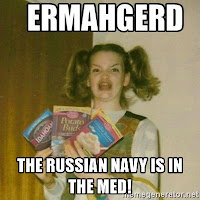Many navalists were having one of those moments to start the week, especially those of us old enough to remember the Cold War.
Here's the quote in question;
Recent Russian naval activity in Europe exceeds levels seen during the Cold War, a top U.S. and NATO military officer said, voicing concern that the distributed nature of the deployments could end up "splitting and distracting" the transatlantic alliance.I'm sorry, but time to be a skunk at the "Ermahgerd Russians!" party.
Navy Admiral Michelle Howard, who heads NATO's Allied Joint Force Command in Naples and commands U.S. naval forces in Europe and Africa, said Russia had clearly stepped up its naval actions in recent years although the size of its navy was smaller now than during the Cold War era.
"We're seeing activity that we didn't even see when it was the Soviet Union. It's precedential activity," Howard told Reuters in an interview late on Saturday during a missile defense conference.
Howard cited a wide range of activities, including Russia's deployment of its Admiral Kuznetsov aircraft carrier to the Mediterranean, increased patrols in the north Atlantic and Arctic region, significant out-of-area submarine deployments, and submarine movement in the Black Sea.
I knew the Soviet Navy in the Cold War, and as a young JO, cut my teeth chasing the last few of them around the Med .... and the Russian Navy is not the Soviet Navy.
Let's just run the numbers. First of all, let's define the "Cold War." Plus or minus an American election cycle, can we agree that the classic years of the Cold War from a naval perspective were from 1965 to 1985? OK, then lets look at the numbers, shall we?
Referencing Gordon H. McCormick's 1987 RAND study, "The Soviet Presence in the Mediterranean," what were the average number of Soviet ships in the Med each day?
That is an average daily strength in the Med of about 45 ships. At the most, what did the Russians have in the Med in the last year, 10? 12?
Heck, as our friend Bryan McGrath pointed out, at the peak of the Yom Kippur War, things in the eastern Med were a bit sporty.
Lyle J. Goldstein and Yuri M. Zhukov point out in their 2004 Naval War College Review article, "A TALE OF TWO FLEETS: A Russian Perspective on the 1973 Naval Standoff in the Mediterranean," that in the Med in 1973 it was quite the, "Happy Halloween there Shipmate!"
The Fifth Eskadra’s force strength peaked on 31 October at ninety-six units, including thirtyfour surface combatants (five armed with SSMs) and twenty-three submarines (at least seven with SSMs), constituting a force capable of launching eighty-eight SSMs in a first salvo.I don't think such exaggerated hyperbole coming out of a 4-star is doing anyone any good. It distorts historical perspectives and unnecessarily puts everyone on edge.
The sixty U.S. ships then present, including three attack carriers, two amphibious assault helicopter carriers, and nine attack submarines, found themselves in an increasingly uncomfortable position, in which a preemptive strike seemed the most attractive option should combat seem inevitable. Around each carrier were three Soviet ships—two destroyers (one carrying surface-to-surface missiles, the other surface-to-air) and one “tattletale” AGI capable of providing midcourse guidance to SSMs fired from elsewhere.
If the situation ashore had been defused, the crisis at sea not only persisted but now reached its most dangerous stage. The four U.S. task groups were constantly targeted for a Soviet attack. The three anticarrier groups trailing the U.S. carrier groups could have launched first salvos of at least thirteen SSMs each against their respective targets. Four Soviet cruise-missile submarines were on submerged patrol nearby. The U.S. amphibious task force south of Crete was likewise shadowed by a group of five Soviet warships, some equipped with SSMs.
When you increase emotion, decrease historical perspective, and blinker nuance - you limit the flexibility and decision making processes of everyone.
Unmoored hyperbole increases the odds of bad decisions and even worse - when such statements are easily debunked with 5-minutes on google - it degrades the standing of US military leadership and the nation it serves.
Let's try to keep such hyperbole and abuse of the English language to our FITREPS, and out of our national security discussions.
Hat tip McGrath.













No comments:
Post a Comment